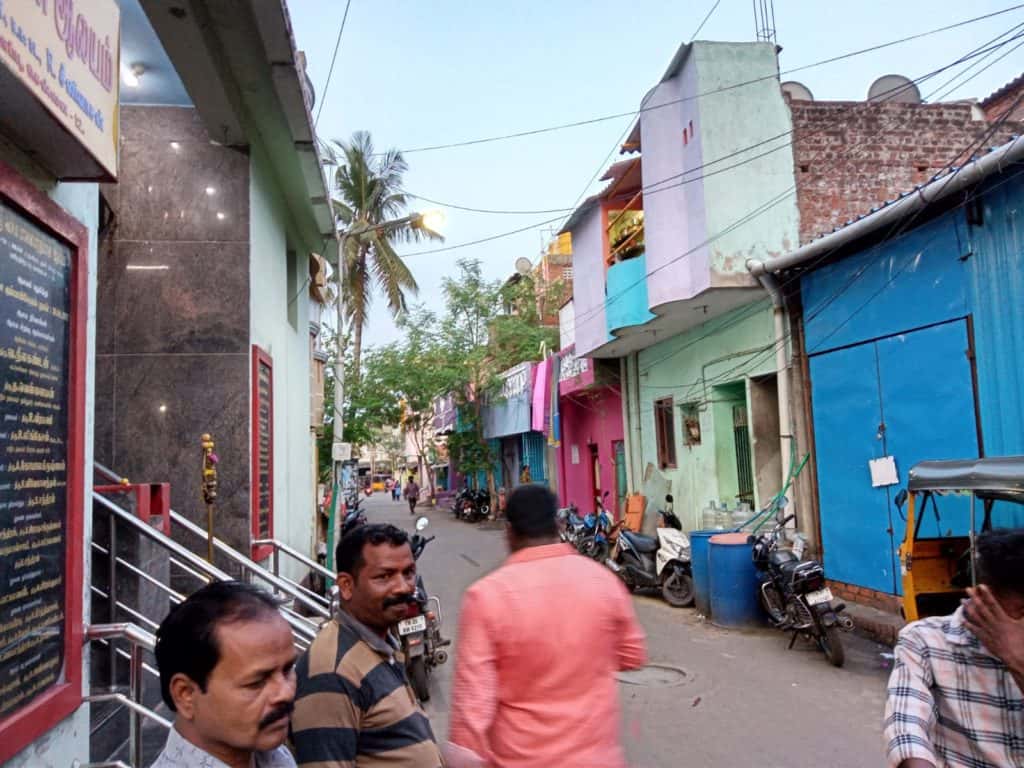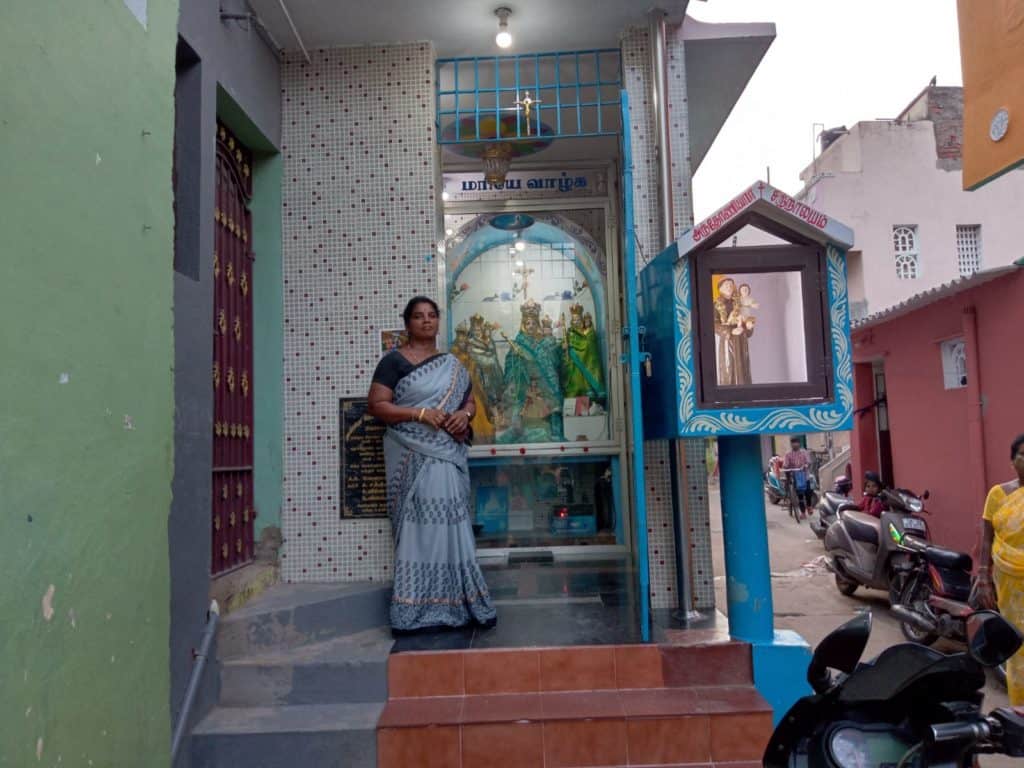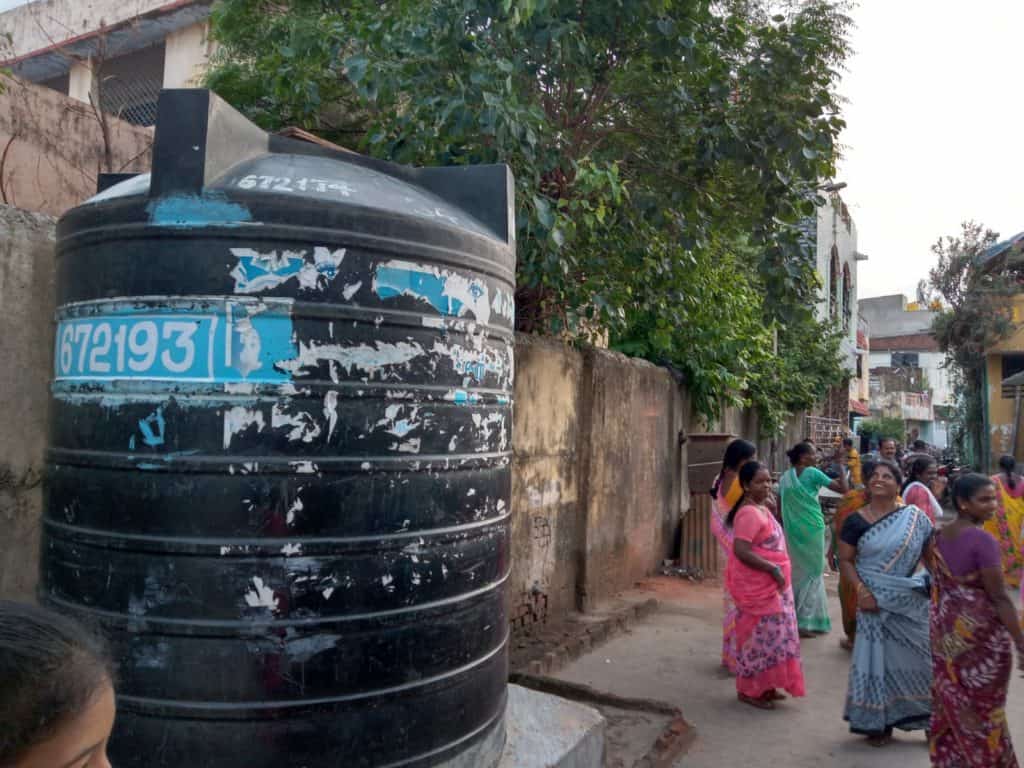“People are guarded around us, they keep a distance. They say the men from our area are drug dealers, they do ganja, and they drink and murder people in their stupor. Even very many autos do not come into our neighbourhood. Media reports have spoken of us, as killers and drug addicts”, said Velankanni, a resident of Thiru Vi Ka Nagar in Pulianthope.
Long-standing stigma around Pulianthope has marked residents as innate criminals, worsened this neglect, and created a narrative that these are ‘undeserving and dangerous’ citizens of the city.
Reputation that hurts residents
Pulianthope has developed a reputation for housing ‘notorious gangs of Chennai’. Residents noted that even in casual conversation, those from other parts of the city speak of Pulianthope as an area full of rowdies, drugs, and danger.
According to Selvaraj, the President of the Pulianthope Podhu Nala Sangam, started in 2021, the negative perception of Pulianthope affects residents adversely in various aspects of daily life.
“Post-paid data connections are denied, marriage alliances are broken, government loans rejected, once we disclose the area name. Many have even left our area; they have sold or rented out their ancestral houses and moved away to get away from the stigma associated with living here,” he said.
“No one wants to marry a woman from Pulianthope” said Velankanni. “Once they hear that she is from there, they do not want to proceed with the match, saying that woman comes from a family of killers. They don’t even want to enter our area.”
In the testimonies of those from the area, the reaction of fear and disgust to the area name from those from other parts of the city, seems automatic, impulsive even. Many mention how politicians, government officials, auto drivers, and even friends are unwilling to enter the area.
Others also mentioned that often there is a general idea that slums are hotbeds for criminal activity, and this could contribute to the treatment they get when revealing their area name.
“When you say you are from Pulianthope, people automatically register that it is a slum, and think of us as uneducated. Maybe this is why they might’ve spread this rumour of our area being full of rowdies”, said S Sharmila, a 21-year-old law student.
Residents mentioned that despite many of them being educated they are often rejected from jobs, or even underemployed, as there is a lack of recognition given to them, as one of the women in the area put it.
“We started a table tennis academy in Nehru Street to provide some extracurricular activities for the children. The kids from this academy, who go out for competitions, get scolded for every little thing. Those overseeing these competitions mention Pulianthope when they chastise them. They start calling us by caste names, they say poriki (scoundrel) to refer to kids”, said E Murugan, a resident of the area.
“Many first-generation learners in the area went to Thyagaraja College for their undergraduate degrees. We were treated pretty badly. When we studied there and were asked where we were from, it was clear that they started to see us as untouchables as soon as we mentioned Pulianthope”, shared Murugan.
“People call us uneducated, arivu illadha aalu (people without intelligence), as we are from slums. We never get the recognition for our work or our studies; everyone has been getting educated in our area as well, yet they think of us as illiterate”, Murugan added.
Read more: Irregular water supply not just a seasonal issue for many Chennai families
Role of caste in marginalization
The majority of the residents here are from oppressed castes and engaged in blue-collar work. Many work in the Corporation-owned aaduthotti (abattoir), which is the biggest abattoir in the city.
Many residents felt that the reputation the area has developed has in part been due to discomfort outsiders had around the abattoir and those that worked with meat, especially cow meat, and blood on a daily basis.
“The aaduthotti (abattoir) is there in our area, so every morning people working at the slaughterhouse would go to work, with large knives in their hands, to cut the meat. Seeing this has created a perception among people of the area being full of rowdies. Ultimately the stigma is planted based on three things: our caste, our area, and the meat that we eat and work with”, said Murugan.
K. Sreenivasan, a resident working as an auto driver echoed the sentiment when he said, “People see those working at the abattoir and feel a sense of disgust, from the outside. They see them drink in shops after their shift gets done and this makes them feel suspicious. I think this type of stigma is attached to many areas in North Chennai.”
A picture of neglect
Spatial segregation along caste lines stems from perceived notions of impurity that are based on the caste-based work that takes place in these spaces and the population of people from oppressed castes who reside in these areas.
Despite the promise of freedom, equal opportunity, and choice attached to cities and urbanisation, allowing individuals to live anonymously and break away from caste markers, similar segregation of space can be seen in cities as well.
On visiting certain parts of Pulianthope such as Thiru Vi Ka Nagar, VOC Nagar, Nehru Nagar, this concentration of neglect was clear.
“No MLA or MP has ever come into our streets, and looked at our homes, no AE or JE comes in here and tries to see our reality. Over the years, election promises have been made, but entry into the area itself rarely happens. This has remained the same across governments”, said K Jeyachandran, Treasurer of the Pulianthope Podhu Nala Sangam.
Many residents said that issues around the availability and quality of water were a key concern in the area.
“Metro Water is one of our biggest concerns. Only a few houses have water and sewage piped connections set up more than 50 years ago. For usable water, everyone mainly depends on Metro water lorries which come in and fill in the tanks every morning for which we have to pay an informal fee of 10 to 15 rupees per day,” said Jeyachandran.
He added, “Whenever we approach Metro Water Board with these concerns, we are told that the process will take time owing to us not having tar roads but only cement roads. The roads department continues to relay only cement roads in our areas, despite years of protest from our side requesting tar roads, so as to lay piped connections. Only one tar road has been laid in our area, after years of protest.”
For those with piped connections, often the sewage and the drinking water get mixed, due to low pressure, and old pipes. Many open ditches and haphazardly maintained potholes are scattered throughout the area.
The cement roads have led to many problems for the residents, especially when the rains arrive.

“In the last five years they’ve relayed the cement two to three times. What happens is the road level has become too high, and water from rains, and the nearby Otteri nullah completely floods into our homes. Rains are our biggest fear. For those in the other side of town, when rains come in they feel excited. For us, it just means a lot of pain and struggle. This is the difference between us and them”, said a woman resident of Thiru Vi Ka Nagar who did not want to be named.
Assertion of community
Many of the residents state that the nature of relationships in the area was one of community feeling and love, rather than that of brutality that colours any mention of Pulianthope in the mainstream.
“Everyone is like a family. If even one of us has a small problem in the area, the whole area will stand together to sort it out. The people here are full of love”, said Murugan.
R Viji, a part-time tuition teacher at the Tamil Nadu Housing Board School, mentioned how while moving back to Pulianthope, she had several fears related to violence in the area.
“My daughter and I moved back to Pulianthope 12 years ago. I was scared of moving my daughter to a place known for violence, but once we settled down, the fear abated. The sense of family and connectedness was very much present among everyone”, she said.
Read more: Pulianthope Welfare Assembly shows the way for RWAs in Chennai
Many attempts to counter casteist narratives have been undertaken by those within the area. A key focus of residents is education. The Ambedkar Mandram in Thiru Vi Ka Nagar, started by residents more than 50 years ago, conducts free tuition for young kids.
Many of these children who were tutored here have gone on to start their own community endeavours dedicated to the upliftment of Pulianthope. The Pulianthope Podhu Nala Sangam is one such initiative.
The Sangam aims to boost the self-confidence of many of the children in the area through ‘scouts training’. They also circulate job offers and carry out interview preparation for anyone looking to apply for positions in a number of sectors.
Many mention how civic authorities have started to become more cooperative to residents, once the association was formed and registered. “Authorities such as those from Metro Water and Greater Chennai Corporation respond better to online applications, letters, and memos that we have sent, as opposed to before when we would individually go and speak to them,” said Selvaraj.
Past history, discrimination and neglect have hampered the progress of residents of Pulianthope, who nevertheless soldier on to challenge notions about the area and those who live there.

